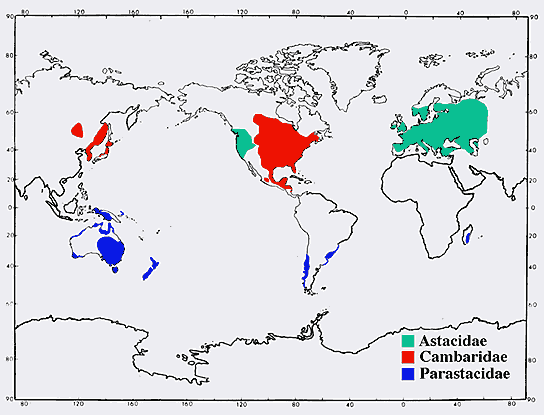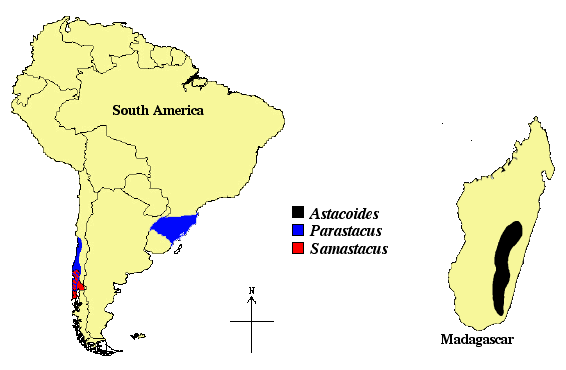
 |
|
|
|
#1 |
|
Guest
Posts: n/a
|
First lets look up the taxanomy of our Crayfish.
I'll go brief and not really into the sub or super classes and orders. Phylum : Adropoda (Segmented Legs + Hard Outer Shell) eg. insects, crabs, scorpions Class : Crustacea Order : Decapods (10 legged) Family : Astacidae, Cambaridae (Northern Hemisphere) Parastacidae (Southern Hemisphere) Below is an extract from http://tolweb.org showing the distribution of the 3 family.  We will be focusing on Parastacidae as its where our local available Crayfish are from. Genus : 14 of them, Astacoides, Astacopsis, Euastacus, Gramastacus, Geocherax, Virilastacus, Samastacus, Cherax, Paranephrops, Parastacoides, Tennuibranchiurus, Engaewa, Engaeus, Parastacus Another extract from http://tolweb.org showing the distribution of Southern Hemisphere Crayfish, Parastacidae  Figure 1. Distribution of the 10 Australian Parastacid genera (from Hobbs 1988). The Tennuibranchiurus and Engaeus are shown only in the second map on the right inset.  Figure 2. Distributions of the remaining Parastacid genera. Note that there is an overlap of Parastacus and Samastacus in central Chile that is not depicted very well in the graphic. |

|
|
|
#2 |
|
Guest
Posts: n/a
|
From http://tolweb.org
Cherax in 5 sub groups Destructor Group Cherax albidus Cherax destructor Punctatus Group Cherax neopunctatus Cherax depressus Cherax cairnsensis Cherax wasselli Cherax gladstonensis Cherax glaber Cherax urospinosus Cherax robustus Cherax cartalacoolah Cherax punctatus Cherax rotundus Dispar Group Cherax cuspidatus Cherax dispar Quinquecarinatus Group Cherax preissii Cherax plebejus Cherax glabrimanus Cherax neocarinatus Cherax quinquecarinatus Cherax crassimanus Quadricarinatus Group Cherax divergens Cherax lorentzi Cherax quadricarinatus Cherax tenuimanus Cherax rhynchotus Cherax monticola Cherax barretti Cherax nucifraga Cherax parvus |

|
|
|
#3 |
|
Guest
Posts: n/a
|
|

|
|
|
#4 |
|
Guest
Posts: n/a
|
Anatomy from http://www.crayfishworld.com
 1. Rostral carinae 2. Mandibles 3. Carpus, leads to the main claw ( chela ), the section between the carpus and the main body is the merus. There are five sets of legs on all decapod, simlply ten legs. 4. Carapace 5. On these legs the female gonopore 6. On these legs if male, the male gonopores 7. Spines 8. Somites, there are five sections 9. Eggs, this particular female is in 'berry'. 10. Telsons, once again five sections by Pierre Horwitz |

|
|
|
#5 |
|
Guest
Posts: n/a
|
|

|
|
|
#6 |
|
Guest
Posts: n/a
|
|

|
|
|
#7 |
|
Guest
Posts: n/a
|
Selecting A Healthy Crayfish.
Any LFS will carry at least 1 or 2 species of cray fish. The most common tat we see ard are the Reds and the Blues (Cherax quadricarinatus). Both are highly recommended for beginers and can get at $1-$3 a piece. In LFS, the common practice is to keep the crayfish in a crowded plastic tank with probably 1cm depth of water. This allows the crayfish's gills to be sufficiently moist and let them stay alive. This is strongly discourage as its different from the crayfish natural environment and not the best type of surronding we can create for the crayfish. The overcrowding situation plus little water causes stress to the crayfish and for some, eventually death. When chosing a crayfish, make sure that its lively and with complete limbs. To ensure tat one is lively, lower ur hand onto the crayfish. Normal reaction for crayfish is tat they will move back while raising both their pincers in a defensive mood. Some dying or unhealthy crayfish will just lie there without any response. To catch the crayfish, try and approach from its back and hold the end of its carapace with ur tumb and index finger. Choosing complete limbs are as important, expecially the front 2 claws(pincers). Firstly, they require them to catch prey, secondly they need them to protect themselves and thirdly, it look nicer to have them. You might notice tat some hav both pincer pretty small compared to others, or one big one small. This would be due to that it lost one of it before. New grown one are much smaller, yes they do grow back their limbs after moulting. Thus, get ur selected crayfish, and bring home. Housing Crayfish A 2'x1' tank is more than sufficient for a couple of crayfish. i always follow this rule, 6 inch square per crayfish. this shld be reasonable for all crayfish below 5". in the tank, provide lots of hiding places. for example if i hav 4 blue crayfish in a 2' tank, i will probably throw in 6 or 7 PVC pipes or lava rocks. When selecting these 'hidding places' ensure tat they are big enough for the whole crayfish to move in and out easily. the last think u want to see is a crayfish stuck in a PVC pipe! Lava rocks in my opinion are very nice and of cos pretty expensive. But my crayfishes like them alot and they look great in my tank. Other than hidding places, strong aeration is needed. its hard to gauge how strong is 'strong', think just give the most tat u can supply it. Filtration wise does not have to put too much effort in it. For me, corner bubble filter work just fine. One think u hav to know is that crayfish are very hardy! But one think to remember is tat they don't do well in acidic water. Crayfish don't require strong lighting as well. Normally, they hunt at night. Feeding Crayfish Crayfish take almost anything, yes! Anything. In the wild, they eat the dirt or unwanted organisms. u can feed them with small feeder fishes, sinking pellets and with some veg like small pieces of carrots. Dun ever feed them with feeder shrimps. Shrimps tend to carry certain diseases which are lethal towards crayfish. Wat i do is put in one small pack of feeder mollies and feed Hikari Crab Crusine pellets every night. That is the most expensive pellets u can get for ur crayfish. Ard $4+ per pack of 50g. Feed when u are just about to switch off the aquarium light, cos they hunt at night. but i read somewhere before that the adult crayfish hunt at night, but the young one are more active in day time. Dun really know how ture is this, therefore, i leave small mollies in the tank all the time. Growing Crayfish grow by moulting. The shell just behind the carapace(neck) will split open while the crayfish will push itself out of its old shell. Younger crayfish moult more oftenly. New borns the size of a rice moult once every few hours. 1"-2" moult a few times a week. 3"-5" probably once every few weeks. when older, probably once every few months. this is just a rough gauge and it vary from species to species. After moulting, the crayfish will grow quickly before its new shell harden. After every moult, a crayfish can put on as much as 50% of its body's original mass! When a crayfish moult, they become very vulnerable. Some people have the practice of removing those which just moulted just incase other crayfish kill it. Normally, crayfish will eat up its old shell almost immediately after moulting. Some people likes to remove the old shell and keep it. i personally don't encourage this as the old shell are full of calcium which the crayfish needs for healty shell or shorter hardening period. therefore, just let the crayfish recycle its shell. |

|
|
|
#8 |
|
Moderator
      Join Date: Mar 2004
Posts: 7,140
|
Last edited by amiidae; 20-10-2005 at 07:23 PM. |
|
|

|
|
|
#9 |
|
Guest
Posts: n/a
|
great posting of info...
The only thing that I will add from my experiance of many years importing, growing and breeding Walkamin Strain Redclaw is Water Quality Water Quality Water Quality |

|
|
|
#10 |
|
Guest
Posts: n/a
|
bros any tips on breeding the common red or blue?? cheers

|

|
 |
|
| Currently Active Users Viewing This Thread: 1 (0 members and 1 guests) | |
|
|